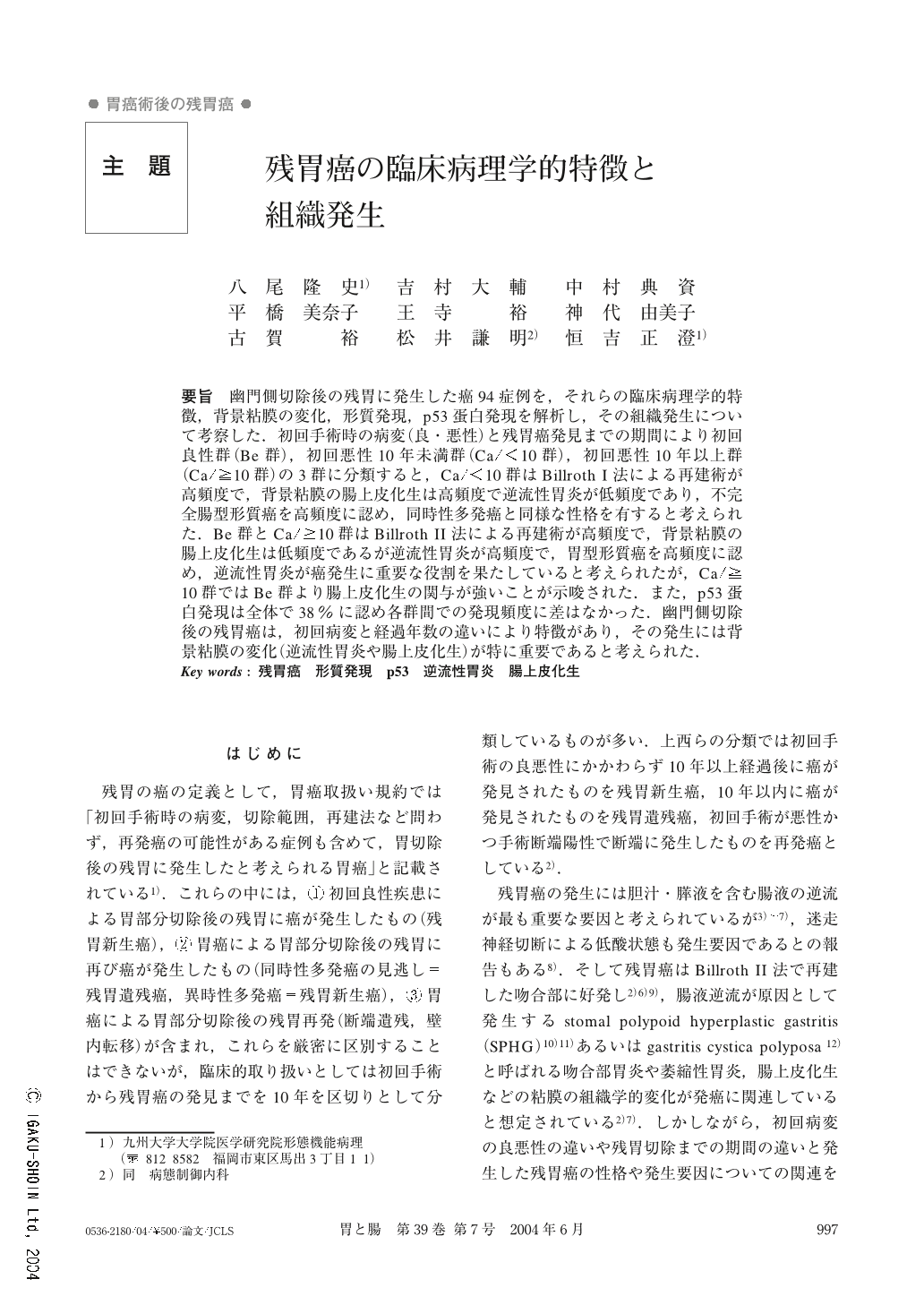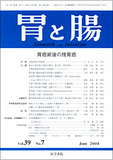Japanese
English
- 有料閲覧
- Abstract 文献概要
- 1ページ目 Look Inside
- 参考文献 Reference
- サイト内被引用 Cited by
要旨 幽門側切除後の残胃に発生した癌94症例を,それらの臨床病理学的特徴,背景粘膜の変化,形質発現,p53蛋白発現を解析し,その組織発生について考察した.初回手術時の病変(良・悪性)と残胃癌発見までの期間により初回良性群(Be群),初回悪性10年未満群(Ca/<10群),初回悪性10年以上群(Ca/≧10群)の3群に分類すると,Ca/<10群はBillroth I法による再建術が高頻度で,背景粘膜の腸上皮化生は高頻度で逆流性胃炎が低頻度であり,不完全腸型形質癌を高頻度に認め,同時性多発癌と同様な性格を有すると考えられた.Be群とCa/≧10群はBillroth II法による再建術が高頻度で,背景粘膜の腸上皮化生は低頻度であるが逆流性胃炎が高頻度で,胃型形質癌を高頻度に認め,逆流性胃炎が癌発生に重要な役割を果たしていると考えられたが,Ca/≧10群ではBe群より腸上皮化生の関与が強いことが示唆された.また,p53蛋白発現は全体で38%に認め各群間での発現頻度に差はなかった.幽門側切除後の残胃癌は,初回病変と経過年数の違いにより特徴があり,その発生には背景粘膜の変化(逆流性胃炎や腸上皮化生)が特に重要であると考えられた.
Ninety-four cases of gastric remnant cancer after distal gastrectomy were selected for this study, and their clinicopathological features, phenotypic expression and p53 expression were analyzed. The cases were divided into three groups :44 cases following surgery for benign disease (Be-Group) and 22 cases occurring more than 10 years (Ca/≧10-Group) and within 10 years (Ca/<10-Group) after the first gastrectomy for malignant disease. In the Ca/<10-Group, Billroth-I procedure for anastomosis was more frequent, intestinal metaplasia in background mucosa was more frequent, but reflux gastritis was less frequent. The features suggest carcinogenesis of the Ca/<10-Group is similar to that of multiple gastric carcinoma. On the other hand, Billroth-II procedure for anastomosis was more frequent, intestinal metaplasia in background mucosa was less frequent, but reflux gastritis was more frequent. In addition, intestinal metaplasia was more frequent in the Ca/≧10-Group than in the Be-Group. The features suggest carcinogenesis of the Be- and Ca/≧10-Groups is associated with reflux gastritis, and that of the Ca/≧10-Group is also associated with intestinal metaplasia. With regard to the phenotype of the carcinoma, incomplete intestinal type was the most frequent in the Ca/<10-Group, but gastric type was the most frequent in the Be-Group. This is considered to be associated with intestinal metaplasia in their background mucosa. p53 expression was seen in 38% of all the cases, but there was no difference between each group in the incidence of p53 expression.
In conclusion, mechanisms of carcinogenesis of gastric remnant cancer after distal gastrectomy are closely associated with the lesions of the first operation, anastomostic procedure and the interval between the first and second operation. The condition of background mucosa (intestinal metapalsia and reflux gastritis) is considered to be most important for its carcinogenesis.
1) Department of Anatomic Pathology, Graduate School of Medical Sciences, Kyushu University, Fukuoka, Japan

Copyright © 2004, Igaku-Shoin Ltd. All rights reserved.


